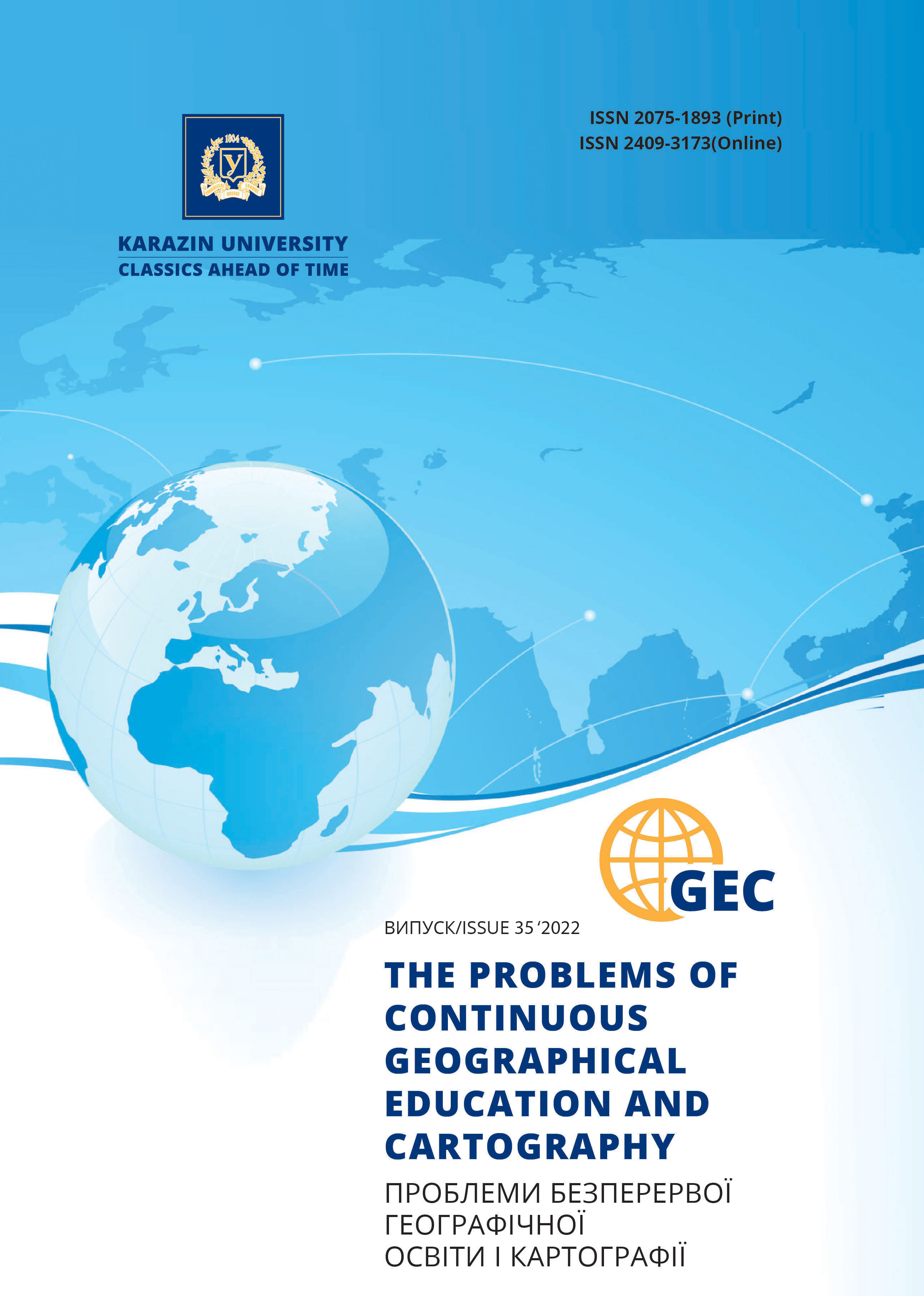Specifics of practical training of geography students in a remote format
Abstract
The purpose of the article is to highlight specifics and give recommendations for practical training of geography students in a remote format based on the teacher experience at the Department of Physical Geography and Cartography at V. N. Karazin Kharkiv National University.
The main material. Long-term and meaningful practical training is an integral part of geographers training at the Department of Physical Geography and Cartography. However, since the summer of 2020, we conducted almost all field training of the Department remotely, initially due to the COVID-19 pandemic, currently – due to military operations. The article reveals the specifics of the educational natural science training of the first-year students and the professionally oriented educational training of the second-year students in this format. Remote organization of practical training involves daily synchronous activities in the format of a video conference, followed by questions for self-examination and self-monitoring. The first preparatory step for teachers was the transformation of typical training routes into the format of online lectures and online demonstrations. The second one was the implementation of new types of independent work of students, such as visual analysis of remote sensing data for the Carpathian region, development of training routes through the Carpathians, preparation of reports with presentations about significant objects of the historical and cultural heritage of Ukraine. If lectures are the component of practical training that has significantly improved with the transition to a remote format, then online demonstrations have appeared to be difficult to organize. The main inconvenience during the war is the difficulty or impossibility of finding a physical object adequate for educational purposes within the teacher’s reach and accessing the Internet connection in the area. According to our experience, only the hydrological section of the first-year students’ practical training seemed convenient in this regard. In particular, during the practical training in 2022, students 15 mastered the process of measuring physical characteristics and performing water chemical express test using educational and scientific equipment.
Conclusions and further research. It is impossible to transfer the practical training of geography students only to a remote format, because many aspects such as field training, ‘live’ communication between students and teachers, the group fieldwork is lost in this way. If the tasks of the preparatory and cameral stages of the practical training are well adapted to distance learning, the direct field study of natural objects using devices is a unique educational experience that has no full analogues. Nevertheless, if the teachers have to conduct the practical training in the online mode, there are ways to improve this component of the educational process such as involving various media materials, organizing synchronous online demonstrations, using interesting tasks for independent work of students, and making all stages of the practical training interactive.
Downloads
References
Barna, M.,M., Barna, L.S. (2021). Special features of the methodology of conducting practical training in the module ‘Botany. Anatomy and plant morphology’ in conditions of distance learning. Proceedings of the III International Scientific and Practical Conference ‘Preparation of Future Teachers of Physics, Chemistry, Biology and Natural Sciences in the Context of the Requirements of the New Ukrainian School’. Ternopil, 116–119 [in Ukrainian].
Borysenko, K.B. (2019). The professional competencies formation of future geography teachers in the process of educational practice: Dis. in pedagogical sciences on the specialty 13.00.04. Ukrainian Engineering Pedagogics Academy. Kharkiv, 350 [in Ukrainian].
Vovk, O.I., Kudelko, S.M. (2020). Local lore practice in quarantine regime (experience, problems, view in the future)]. Problems of modern education, 11, 70–74 [in Ukrainian].
Yashchenko, E., Levandovska, I. (2021). Distance Education in a High School Educational Activity: Challenges of Time. Humanitarian studies: history and pedagogy, 1, 124–134 [in Ukrainian].
Hodges, C.B., Moore, S., Lockee, B.B., Trust, T., Bond, A. (2020). The difference between emergency remote teaching and online learning. International declaration on research in geography education. Available at: https://er.educause.edu/articles/2020/3/the-difference-between-emergency-remote-teaching-and-online-learning [in English].
Hutchinson, S. M., Bacon, K. L., Bunting, M. J., Hurrell, E. R. (2022). The Virtual Palaeosciences (ViPs) project: resources for online learning in or out of a pandemic. Journal of Geography in Higher Education. Available at: https://www.tandfonline.com/doi/full/10.1080/03098265.2022.2129599 [in English].
Sentinel Hub EO Browser. Available at: https://apps.sentinel-hub.com/eo-browser/ [in English].
SoilWeb200. Faculty of Land and Food Systems. University of British Columbia. Available at: https://soilweb200.landfood.ubc.ca/ [in English].
Swonton, D.A. (2020). A local alternative to field courses. Teaching Matters blog. Available at: https://www.teaching-matters-blog.ed.ac.uk/a-local-alternative-to-field-courses/ [in English].

This work is licensed under a Creative Commons Attribution 4.0 International License.





